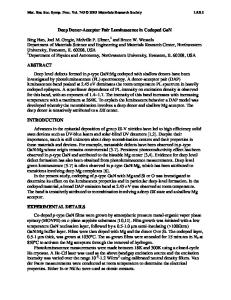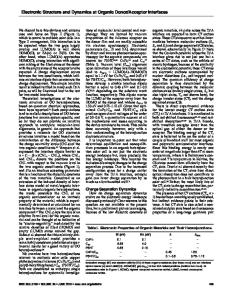Activation Characteristics of Donor and Acceptor Implants in GaN
- PDF / 1,666,910 Bytes
- 6 Pages / 417.6 x 639 pts Page_size
- 87 Downloads / 369 Views
"**Consultant, Stevenson
Ranch, CA 91381, USA ***Micropyretics Heaters International, Inc. Cincinnati, OH 45215, USA ****Office of Naval Research, Arlington, VA 22217, USA *****Sandia National Laboratories, Albuquerque, NM 87185, USA ******Oak Ridge National Laboratory, Solid State Division, Oak Ridge, TN 3783 l,USA *******European Research Office, USARDSG, London, England
ABSTRACT
The ionization levels of different donor and acceptor species implanted into GaN were measured by temperature-dependent Hall data after high temperature (1400 'C) annealing. The values obtained were 28 meV (Si), 48 meV (S), 50 meV (Te) for the donors, and 170 meV for Mg acceptor. P-type conductivity was not achieved with either Be or C implantation. Basically all of the implanted species show no distribution during activation annealing. For high implant doses (O 1015 Ccm2 ) a high concentration of extended defects remains after 1100 'C anneals, but higher temperatures (1400 'C) produces a significant improvement in crystalline quality in the implanted region. INTRODUCTION
Ion implantation is an effective technology for selected-area doping or isolation of GaN-
based devices.'- 3 As reviewed previously by Zolper,' implantation of donors at high dose (>5x 1014 cm" 2) can be used to decrease source and drain access resistance in field effect transistors (FETs), at lower doses to create channel regions for FETs, while sequential implantation of both acceptors and donors may be used to fabricate p-n junctions. Two different device structures have been demonstrated using the latter method, namely a junction field-effect transistor 2 and a planar, homojunction light-emitting diode (LED).4 At high implant doses (2!5x 1014 cm-2) it is clear that conventional rapid thermal annealing (RTA) at 1100-1200 °C can activate the dopants but not remove the ion-induced structural damage. 5 At higher annealing temperatures (Ž1400 °C), the equilibrium N 2 pressure over GaN is >1000 bar, 6 and only two methods have proven effective in preventing surface decomposition. The first is use of high N 2 pressures (15 kbar),7 and the second is deposition of AIN encapsulation layers 8 (at 1400 'C the equilibrium N 2 pressure above AIN is only 10.8 bar). The latter is clearly more convenient. What is needed is a better understanding of the optimum implanted species for creation of nand p-type regions in GaN, based on the highest achievable electron or hole concentrations, the residual damage and the redistribution during high temperature annealing. In this paper we report on the high temperature activation characteristics of donor implant species (Si, S and Te) and 513 Mat. Res. Soc. Symp. Proc. Vol. 572 © 1999 Materials Research Society
acceptor species (Mg and C). The redistribution of all these dopants plus Se and Be was investigated by using secondary ion mass spectrometry (SIMS). Finally, the efficiency of high temperature RTA for removing lattice damage in implanted GaN was examined by transmission electron microscopy (TEM). EXPERIMENTAL Layers of GaN 2-3 .
Data Loading...









